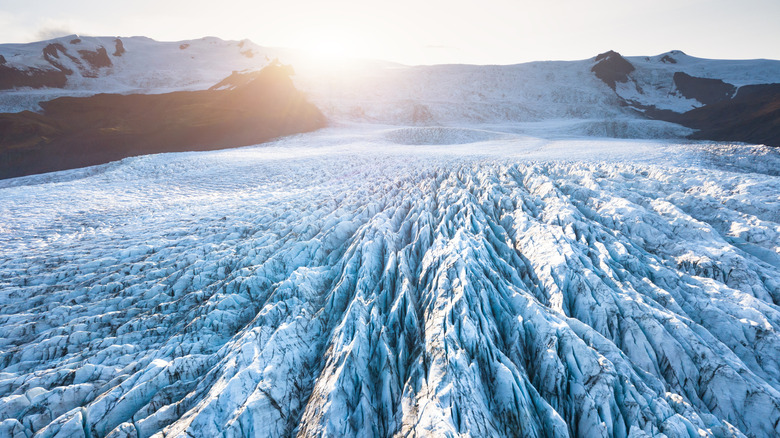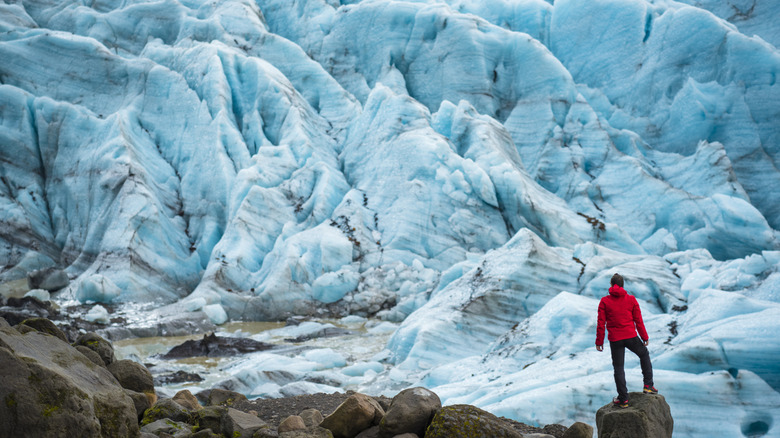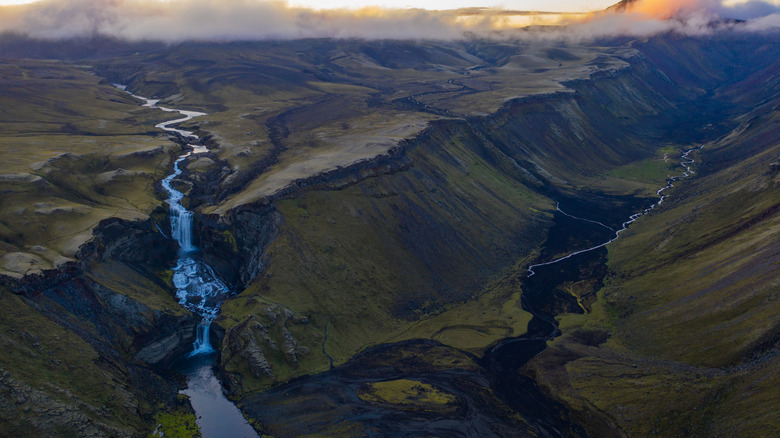
No one understood the brutality and wonder of Iceland better than its original 9th-to-10th-century Norwegian settlers. They set sail into the open ocean, landed on an island riven by impassable glacial striations and seething, active volcanoes, and dug in to build homesteads. What better place to mimic their exploratory passage than the largest glacier in Europe that stretches across a national park that covers 14% of the entirety of Iceland? Welcome to Vatnajökull, in a park of the same name, Vatnajökull National
Park.
Located on the other side of Iceland away from its capital, you're not going to visit Vatnajökull without a vehicle and a four-hour drive along one road, Route 1, from Reykjavík. Vatnajökull's 3,100-square-mile expanse covers 8% of the entirety of Iceland, has an average thickness of about 1,300 feet, and fills the majority of Vatnajökull National Park. The park has 10 access points around its perimeter (most with visitor's centers) and not much else except for the rare farmer, outdoorsperson, or wilderness guide living along the edge of habitability.
Folks looking to visit Vatnajökull National Park can pinpoint the central glacier and brave a very daring, guided climb, or explore Vatnajökull National Park around the glacier's periphery. Options include the craggy and green-filled volcanic canyon, Eldgjá, the blackened and desolate Tungnaáröræfi, the thunderous waterfalls of Dettifloss further north, or the choppy ice of any of Vatnajökull's 30 outlet glaciers. While the region's biggest draw is nothing more complex than a hike (a very slippery, risky one at that), Vatnajökull's blue, glossy ice caves stand out as a potent tourist attraction. But, visitors need to be on constant lookout for trail and road closures, volcanic eruptions, dangers related to increased temperatures, and more perils.
Read more: Why You Should Think Twice Before Visiting These Dangerous European Destinations
Brave A Guided Ice Climb Along Vatnajökull

Visitors to the heart of Vatnajökull National Park -- Vatnajökull, the glacier -- will have one goal in mind: to climb it. Using a combination of modern gear, fully mapped routes, and a 100% mandatory expert guide, you can ford out onto the glaciers as safely as possible. The Icelandic Road and Coastal Administration (IRCA) has up-to-date information on road and wind conditions, while sites like SafeTravel even have an app with real-time updates about volcanoes, earthquakes, weather, etc. And don't take chances with clothing -- be as warm, waterproof, and slip-resistant as possible. As IcelandTravel says, "There's no such thing as bad weather, just bad clothing."
Ice climbs typically start at a meeting point like Skaftafellsstofa Visitor Centre along the southern edge of Vatnajökull National Park. From there, some tours head directly into Skaftafellsjökull, a colossus of jagged ice that cuts past black mountains. Other tours head out from the visitor center to nearby Falljökull, a slowly-sliding outlet glacier in a caldera that serves as another one of Vatnajökull's main access spots.
Tours universally include ice axes for scaling glaciers, crampons, helmets, and safety gear. And while websites often emphasize that they accommodate people of all skill levels, let's be honest: This isn't something that you're going to attempt unless you're fit and venturesome enough. Tours go year-round, but summer might be the best time to visit Iceland unless you really want to experience its coldest depths or gaze up at its magnificent Northern Lights, visible September through April. However, you never want to visit the ice caves of Vatnajökull National Park in summer, as increasingly dangerous glacial melts can cause walls of ice to come crashing down, and have led to tragic deaths.
Treeking Across Vatnajökull National Park's Primordial Terrain

There's plenty to do at Vatnajökull National Park besides ice climbing along Vatnajökull and its surrounding outlet glaciers. Every single stretch of the park's varied and detail-saturated terrain looks like the unfinished brushstrokes of a mad god lost to midnight painting. If there's one place on Earth where you cannot sound unjustifiably hyperbolic in your praise of its primordial, alien beauty, it's Iceland. Even outside of Vatnajökull National Park there's the 32-mile Laugavegur Trail, one of Europe's most impressive hikes that'll take you past rainbow-striped mountains, glacial ponds, and jade mountainsides all in one.
Within Vatnajökull National Park, visitors can travel to any number of distinctive areas and hike through something totally unique. Askja, for instance, is renowned for its weird landscape, particularly the crystal waters of Öskjuvatn lake side-by-side a sunken, thermal crater, Vìti. Some visitors risk sliding down into the crater to toss their clothes and go for a swim in the crater's warm, oddly milky water. By contrast, the mountain range of Kverkfjöll along the park's northern rim is a reddened and rocky expanse bereft of vegetation except for clumps of moss.
Like Vatnajökull and its ice climbing, any of the park's locations can only be accessed via car. But plan well and take care; the same safety and clothing rules apply: Check the Icelandic Road and Coastal Administration (IRCA) and independent sites like SafeTravel for as up-to-date information as possible about trail and road closures, weather conditions, volcanos, and more. Iceland's splendor can come at a treacherous cost.
Ready to discover more hidden gems and expert travel tips? Subscribe to our free newsletter for access to the world's best-kept travel secrets.
Read the original article on Islands.











